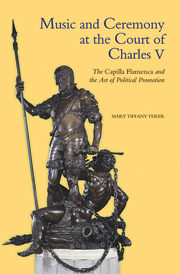 Music and Ceremony at the Court of Charles V
Music and Ceremony at the Court of Charles V Book contents
- Frontmatter
- Contents
- List of Illustrations
- List of Tables
- Preface and Acknowledgements
- List of Abbreviations
- Dedication
- Chapter 1 Charles V: Defender of the Faith and Universal Monarch
- Chapter 2 The Genesis of the Chapel
- Chapter 3 The Reconstruction of the Capilla Flamenca
- Chapter 4 The Chapel Ordinances: Ritual and Repertory at the Court
- Chapter 5 Music and Ceremony at the Court of Charles V
- Chapter 6 Charles V as Crusader and Christian Knight
- Chapter 7 The Presentation of the Emperor
- APPENDIX A Chapel Rosters
- APPENDIX B Chapel Statutes and Ordinances
- APPENDIX C Selected Chapel Personnel
- APPENDIX D Musical Manuscripts, Prints, and Editions
- Glossary
- Bibliography
- Index
Chapter 3 - The Reconstruction of the Capilla Flamenca
Published online by Cambridge University Press: 05 October 2013
- Frontmatter
- Contents
- List of Illustrations
- List of Tables
- Preface and Acknowledgements
- List of Abbreviations
- Dedication
- Chapter 1 Charles V: Defender of the Faith and Universal Monarch
- Chapter 2 The Genesis of the Chapel
- Chapter 3 The Reconstruction of the Capilla Flamenca
- Chapter 4 The Chapel Ordinances: Ritual and Repertory at the Court
- Chapter 5 Music and Ceremony at the Court of Charles V
- Chapter 6 Charles V as Crusader and Christian Knight
- Chapter 7 The Presentation of the Emperor
- APPENDIX A Chapel Rosters
- APPENDIX B Chapel Statutes and Ordinances
- APPENDIX C Selected Chapel Personnel
- APPENDIX D Musical Manuscripts, Prints, and Editions
- Glossary
- Bibliography
- Index
Summary
On 23 January 1516 Ferdinand died, and Charles, as heir to the thrones of Spain, claimed the title of King of Castile, Leon, and Aragon. In ceremonies at the church of St Gudule in Brussels on 13 March of the same year, Juana and Charles were declared co-rulers of Spain. As the words, ‘Long live doña Joanna and don Carlos, the Catholic kings’ rang out, ‘Charles set aside his mourning robe and raised a consecrated sword from the altar to the acclamation of the masses.’ Like Ferdinand, Charles went on to deny Juana her rights as sovereign of Spain and claimed to rule on her behalf. Although deemed unfit and unable to rule, Juana would remain proprietary Queen of Spain until the end of her life in 1555, and Charles would rule in her place. As has been pointed out, ‘without trusting Juana, Charles and his councillors would use the queen to sanction their exercise of royal authority in Spain.’
However, Charles had assumed the thrones of Castile, Leon, and Aragon without setting foot on the Iberian peninsula and without the consent of those he presumed to govern. In Spain Cardinal Francisco Jiménez de Cisneros of Toledo refused to recognize Charles's kingship, perhaps reflecting the resentment of the Spanish towards a king they viewed as a foreigner. Thus on 8 September 1517 Charles departed from the Netherlands for Spain in order to claim his inheritance, be recognized as king, and make peace with the Spanish.
- Type
- Chapter
- Information
- Music and Ceremony at the Court of Charles VThe Capilla Flamenca and the Art of Political Promotion, pp. 66 - 125Publisher: Boydell & BrewerPrint publication year: 2012


